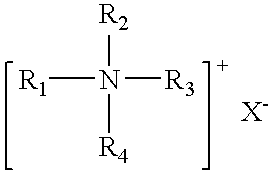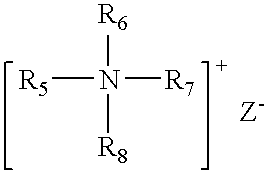Mousse product and method for conditioning hair
a technology for conditioning hair and mousse, applied in the direction of hair cosmetics, pharmaceutical delivery mechanisms, toilet preparations, etc., can solve the problems of significant deleterious effect on the initial and lifetime quality of mouss
- Summary
- Abstract
- Description
- Claims
- Application Information
AI Technical Summary
Problems solved by technology
Method used
Image
Examples
example 1
[0065] A set of experiments were conducted to evaluate the effect of different levels of cyclomethicone (D5) and dimethiconol on foam properties. The test formulas are outlined in Table I. Formula A utilizes cetrimonium chloride as the cationic surfactant and Quaternium-18 as an adjunct oil-soluble type conditioner. Formula B utilizes cetrimonium chloride as the cationic surfactant and is the sole quaternary ammonium component. Formula A and B compositions were placed into aluminum canisters lined with PAM and fitted with dispensing valves having a total orifice are of 0.000981748 in2 (0.63 mm2). The pH of the compositions were held within the range 5.5-6.2.
[0066] The foam was characterized in a Rheometric ARES Rheometer using a 50 mm parallel plate geometry with 2.5 mm gap spacing at 25° C. This larger than normal gap spacing was necessary because some of the poorer quality foams can be squashed and collapsed pre-maturely with smaller spacings. To improve sensitivity of the larger...
example 2
[0071] Effects of small amounts of D5 were evaluated in a large scale consumer test. There were 186 participants. Each participant evaluated two formulas. These were essentially identical to the base Formula A shown in Table I of the first Example. The first test formula (I) incorporated 0.3% (active basis) dimethiconol but no D5. The second formula (II) besides 0.3% dimethiconol was charged with 0.1 5% D5. The participants were requested to rate the following attributes: [0072] PERFORMANCE ATTRIBUTES [0073] More Manageable [0074] More Volume / fullness [0075] More Root Lift / Poofiness [0076] More Body [0077] Less Buildup [0078] Style Lasts Longer
[0079] Formula II was statistically favored (95% confidence level) for all of the above listed performance attributes. Again this test confirmed that a small amount of D5 provided unexpected performance advantages.
example 3
[0080] This Example reports a study to determine optimum total orifice size. A formula similar to that reported in Table I was charged into a pressurized aluminum can lined with PAM to resist corrosion. Two different valves were evaluated. The first had a total orifice area of 0.000981748 in2 (0.63 mm2). The second had a total orifice area of 0.000132732 in2 (0.086 mm2). Poor results were found with respect to the latter in the clinical properties of spray rate, evacuation and ease of dispensing. By contrast, the valve with total surface area of 0.000981748 in2 (0.63 mm2) had very satisfactory performance for all of the dispensing criteria.
PUM
| Property | Measurement | Unit |
|---|---|---|
| orifice size | aaaaa | aaaaa |
| weight | aaaaa | aaaaa |
| molecular weight | aaaaa | aaaaa |
Abstract
Description
Claims
Application Information
 Login to View More
Login to View More - R&D
- Intellectual Property
- Life Sciences
- Materials
- Tech Scout
- Unparalleled Data Quality
- Higher Quality Content
- 60% Fewer Hallucinations
Browse by: Latest US Patents, China's latest patents, Technical Efficacy Thesaurus, Application Domain, Technology Topic, Popular Technical Reports.
© 2025 PatSnap. All rights reserved.Legal|Privacy policy|Modern Slavery Act Transparency Statement|Sitemap|About US| Contact US: help@patsnap.com


